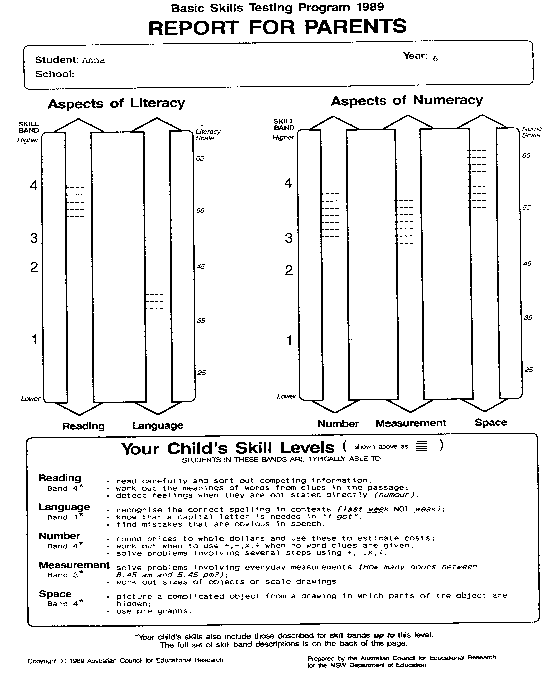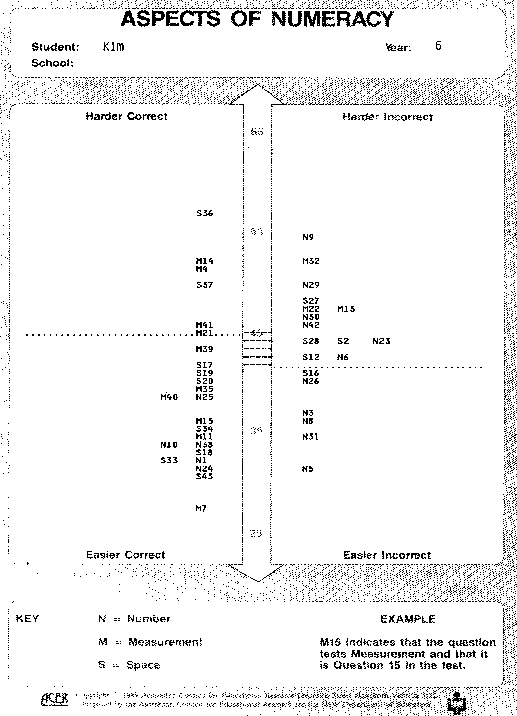
During 1989 Rasch analysis was applied to an entire state school system in Australia for the first time. The government of Australia's largest state, New South Wales, contracted the Australian Council for Educational Research (ACER) to test the Numeracy and Literacy of all children in Year 6 (the final year of elementary schooling in Australia). Test results were required for 56,000 students.
A team led by Dr. Jan Lokan, consulted with the Education Department Curriculum Consultants in Sidney, and specifications for the tests were established. These were:
Numeracy
To consist of equal numbers of questions on Number (addition, subtraction, division, multiplication, common fractions, per cents, and decimals), Space (two-, three-dimensional space, nets of solids, and co-ordinates), and Measurement (money, mass, length, time, temperature, area, and volume).
Literacy
To consist of Language questions (punctuation, spelling), and Grammar, and Reading (comprehension).
A further specification was that, since the tests were to be machine- scored and the children to be tested had no prior experience in formal test situations, some efforts were to be made to reduce the numbers of multiple-choice items. The ingenuity of the item writers was aroused by this last specification, and some innovative forms of response resulted. (See sample items in Figure 1.) Machine-scoring of these alternative response methods was made possible through special programming of optical-scanning equipment.
Trial forms were analyzed using BICAL and ITANAL (an ACER item analysis program). Items with poor fit were discarded. A final mapping of one hundred and fifty items was made, topic by topic, in logit difficulty order.
The final selection of items was made in consultation with Education Department personnel. The final test form contained 43 Numeracy items and 43 Literacy items. In both areas, the question contexts were derived from accompanying stimulus material - a children's magazine for Literacy and a mail order catalogue for Numeracy. The tests were administered in August 1989.
Items were examined for their cognitive requirements. To provide reports for parents, Skill Bands were developed based on those cognitive requirements. The Skill Band Descriptors were the basis for all of the 170,000 reports generated. Parents and teachers were supplied with written descriptions of what each child was "typically able to do". (See sample "Kidmap" report form in Figure 2.) The Education Department was furnished with conventional statistical information as well (state and regional means, and means and standard deviations for sub-populations of girls, boys, Aboriginal, and English-as-a-second-language students).
The reaction of the media and parents to these individualized reports was very positive - probably because children were no longer given "marks" or "pass or fail", but instead were being told exactly what sort of Literacy and Numeracy skills they had acquired.
The use of the Skill Band descriptors to give a criterion-based, non- numerical description of children's strengths was appreciated more often and more favorably than almost any other aspect of the project. In addition to the written reports, teachers received two "Kidmaps" for each student.
The Education Department is favorably impressed with the type of reports generated by Rasch analysis. It is expected that future statewide testing in New South and other parts of Australia will use Rasch methods.
The State Government has been able to use the results of the testing program to assess the resources needed by schools and has announced that efforts will be made to provide schools which the program has revealed as in need with extra resources.
This year (1990) Year 6 will again be tested (on a new test) with similar analyses and reporting formats for all 50,000 students. Work is continuing on the reporting formats, as these are seen to be of great importance for the public "face" of Rasch analysis. Further report formats are currently being developed for use with other tests and in ways that they can be generated by PC for use with item banks.
 |
| Figure 1. Sample Innovative Items |
|---|
 |
| Figure 2. Sample KIDMAP |
|---|
 |
| Figure 3. Skill Band Definition |
|---|
 |
| Figure 4. Sample Diagnostic KIDMAP |
|---|
Rasch Down Under - Kidmaps, B Doig … Rasch Measurement Transactions, 1990, 4:1 p.96-100
| Forum | Rasch Measurement Forum to discuss any Rasch-related topic |
Go to Top of Page
Go to index of all Rasch Measurement Transactions
AERA members: Join the Rasch Measurement SIG and receive the printed version of RMT
Some back issues of RMT are available as bound volumes
Subscribe to Journal of Applied Measurement
Go to Institute for Objective Measurement Home Page. The Rasch Measurement SIG (AERA) thanks the Institute for Objective Measurement for inviting the publication of Rasch Measurement Transactions on the Institute's website, www.rasch.org.
| Coming Rasch-related Events | |
|---|---|
| Jan. 16 - Feb. 13, 2025, Fri.-Fri. | On-line workshop: Rasch Measurement - Core Topics (E. Smith, Winsteps), www.statistics.com |
| Apr. 8 - Apr. 11, 2026, Wed.-Sat. | National Council for Measurement in Education - Los Angeles, CA, ncme.org/events/2026-annual-meeting |
| Apr. 8 - Apr. 12, 2026, Wed.-Sun. | American Educational Research Association - Los Angeles, CA, www.aera.net/AERA2026 |
| May. 15 - June 12, 2026, Fri.-Fri. | On-line workshop: Rasch Measurement - Core Topics (E. Smith, Winsteps), www.statistics.com |
| June 19 - July 25, 2026, Fri.-Sat. | On-line workshop: Rasch Measurement - Further Topics (E. Smith, Winsteps), www.statistics.com |
The URL of this page is www.rasch.org/rmt/rmt41c.htm
Website: www.rasch.org/rmt/contents.htm